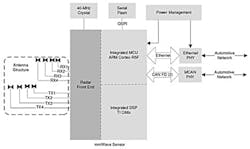This article is part of the TechXchange on Automotive Radar
Members can download this article in PDF format.
How does a supplier of highly precise automotive radar sensors stay on top in a market where competitors are quick to imitate good ideas? By getting better, of course.
In the case of radar, that translates to boosting the ability to respond to hazards. Specifically, it means classifying obstacles and accurately judging their distance, angle, and velocity in any weather or lighting conditions and producing precise, detailed images of the surroundings.
In the past, radar-based solutions were large, expensive, power-hungry, and designed to detect big objects like planes or tanks—not individual pedestrians. They also operated at low frequencies, which results in much less precise imaging.
The Advent of mmWave Radar
To address those issues, Texas Instruments developed millimeter-wave (mmWave) radar sensors that leverage shortwave-length electromagnetic waves operating at 60/77-GHz frequencies for much higher precision. They’re also small and compact, about the size of a coin. And their resolution not only detects the presence of an obstacle, but also recognizes the difference between a car and a pedestrian, fulfilling the latest automotive safety standards on a single chip.
Placed behind automobile bumpers, perhaps in place of dated 24-GHz radar sensors, mmWave radar can more easily see an obstruction on the road to alert the driver. It measures the range, velocity, angle, and elevation of an object from which its mmWave pulse is reflected. In addition, mmWave sensors differentiate themselves from traditional solutions by enabling flexibility and programmability in the RF front-end and the MCU/DSP processing back end.
Designers can use the TI mmWave system to address advanced driver-assistance systems (ADAS) and autonomous-driving safety regulations—including ISO 26262, which enables Automotive Safety Integrity Level (ASIL)-B.
Meeting NCAP Standards
For automated parking and driving, being able to see farther with devices like the new AWR2944 sensor—and then seamlessly process that data with Jacinto processors—leads to improved awareness and safety and meets the requirements of the New Car Assessment Program (NCAP), which calls for better detection of pedestrians.
NCAP is the U.S. government’s premier consumer information program for evaluating vehicle safety, providing an objective rating on a five-star scale. NCAP standards vary by region; in the U.S., NCAP is governed by the National Highway and Traffic Safety Administration (NHTSA).
Similarly, the European New Car Assessment Program (Euro NCAP), which assigns stars based on safety features, will introduce its most stringent safety protocols ever in 2023. In many cases, Euro NCAP has been the first to set standards that raise the bar for the auto industry worldwide. For example, its regulation No. 79 specifies the minimum distance and operation speed for radar in blind-spot detection and lane-change assistance.
Euro NCAP recently updated their standards for radar to improve driver-assistance features in new cars. With longer-range, higher-resolution radar, cars can sense oncoming vehicles faster with detection at farther distances to enable safe lane changes and intersection navigation.
Radar sensors in today’s vehicles encompass front, rear, and corner radar. NCAP regulations for corner radar are intended to make it safer to change lanes. A safe lane-change maneuver is one where the vehicle has sufficient time to react to ensure a safe driving distance between two vehicles.
With back corner sensors to acquire knowledge of the distance and speed of an approaching vehicle and using the known speed of the first vehicle, it’s possible to calculate the critical distance needed at the start of the lane change.
According to TI, the AWR2944 is the first single-chip corner radar sensor that enables carmakers to meet the new safety requirements.
A Closer Look
Upon closer inspection of the AWR2944 single-chip mmWave sensor, it’s built especially for low-power, self-monitored, ultra-accurate radar systems in the automotive space. High-level corner radar performance coupled with best-in-class RF performance is enabled by a fourth transmitter, delivering 33% higher angular resolution than the traditional three transmitter devices.
In addition, the new sensor’s hardware is supported by Doppler-division multiple-access (DDMA) signal processing to improve its ability to sense oncoming vehicles at distances up to 40% farther away.
Built with TI’s low-power, 45-nm RFCMOS process, the AWR2944 mmWave radar integrates a PLL, VCO, mixer, and baseband analog-to-digital converter (ADC). Also worthy of attention is TI's C66x digital signal processor (DSP) for radar signal processing, integrated in the DSP subsystem. Within the main subsystem, the device implements a user-programmable Arm R5F, allowing for custom control and automotive interface applications.
Additionally, the part is provided as a complete platform solution including TI hardware and software reference designs, software drivers, sample configurations, API guides, and user documentation.
For optimal performance, engineers could consider the low-noise PMIC specifically designed to power the AWR2944. TI’s LP87745-Q1 integrates three step-down buck converters, a 5-V boost converter, and a 1.8-V/3.3-V LDO into a single IC. It can reduce power-supply solution cost and cut PCB area by more than 50%, as well as improve low-frequency noise tenfold compared to existing solutions, according to TI.
Safety Inside and Outside
With safety inside the car now a design imperative, mmWave sensors can be used to remind parents about a child in the back seat. In this system, a waveform transmits from the ceiling of the vehicle into the cabin of the parked car.
If an infant or toddler were in the car, the waveform would bounce off their chest, and the technology would detect their breathing and communicate to the central processor to alert the driver, honk the horn, or open the windows to allow air to come in. Just one radar-on-chip can support child presence detection, remind passengers to put on their seatbelts, monitor the driver’s alertness and vital signs, and enable interaction with in-vehicle systems using only hand gestures.
Dana (Dan) Wang, R&D Manager at Texas Instruments, explains how TI mmWave radar can help create a safer world in her “Vision: Possible” blog post. “By using CMOS technology, we significantly increased the integration level of the radar sensor and dramatically reduced the cost,” she said, adding “I think mmWave has huge potential to increase safety in factories, in buildings, at home and in our daily lives. It’s just the beginning.”
Regardless of the simplicity or complexity of the application, mmWave radar solutions are readily available for new and existing industrial and automotive designs. Where to begin? Engineers can jump-start their designs by obtaining the AWR2944 evaluation module (AWR2944EVM).
Check out more content from the TechXchange: Automotive Radar


